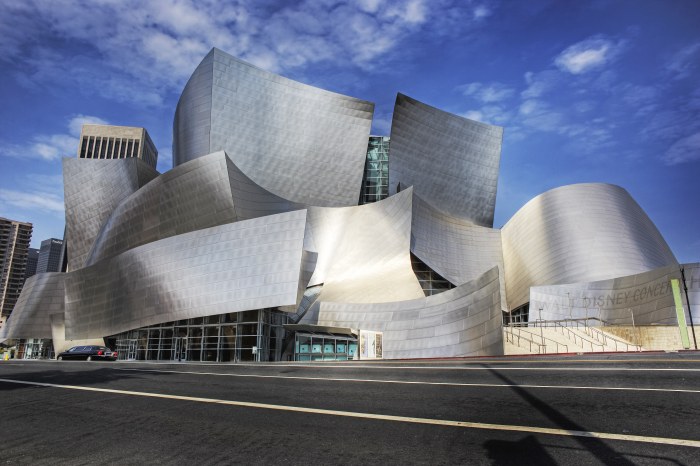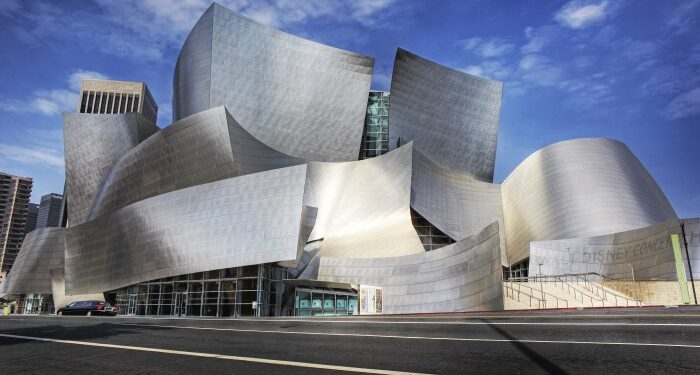Embark on a captivating exploration of modern architecture, a realm where creativity and innovation converge to shape our built environment. This introduction sets the stage for a thought-provoking discussion on the evolution, principles, and notable architects of modern architectural design.
As we delve deeper into the intricacies of modern architecture, we uncover a tapestry of influences, trends, and revolutionary ideas that have redefined the way we perceive and interact with spaces around us.
Overview of Modern Architecture
Modern architecture is characterized by clean lines, minimal ornamentation, and an emphasis on functionality. It emerged in the early 20th century as a response to the ornate and decorative styles of the past. Key elements that define modern architecture include the use of industrial materials such as steel and concrete, open floor plans, and large windows to let in natural light.
Famous Modern Architectural Landmarks
- The Guggenheim Museum in New York City, designed by Frank Lloyd Wright, is a prime example of modern architecture with its distinctive spiral shape and use of concrete and glass.
- The Sydney Opera House in Australia, designed by Jørn Utzon, showcases a modernist approach with its sail-like roof structures and unconventional design.
- The Pompidou Centre in Paris, designed by Renzo Piano and Richard Rogers, is known for its inside-out design where the building's mechanical systems are exposed on the exterior.
Influence on Contemporary Design Trends
Modern architecture has had a significant influence on contemporary design trends, inspiring a focus on simplicity, functionality, and sustainability. Many new buildings today incorporate modernist principles such as open floor plans, energy-efficient features, and the use of recycled materials. The clean and minimalist aesthetic of modern architecture continues to shape the way we think about space and design in the present day.
Evolution of Modern Architecture
Modern architecture has undergone a fascinating evolution over the years, shaped by various factors such as technological advancements, societal changes, and a shift in design principles. Let's delve into the historical development of modern architecture, comparing it with previous styles, analyzing the impact of technology, and discussing the role of sustainability in shaping modern architectural practices.
Historical Development
Modern architecture emerged as a response to the Industrial Revolution in the late 19th and early 20th centuries, breaking away from traditional architectural styles like neoclassical and Gothic. Architects such as Le Corbusier, Frank Lloyd Wright, and Walter Gropius championed the modernist movement, emphasizing simplicity, functionality, and the use of new materials like steel and glass.
Comparison with Previous Styles
Unlike traditional styles that focused on ornate decoration and historical references, modern architecture embraced a minimalist approach, with clean lines, open spaces, and a rejection of unnecessary embellishments. The shift towards functionality and efficiency marked a significant departure from the past, reflecting the changing needs of society.
Impact of Technology
Technological advancements have played a crucial role in the evolution of modern architecture, enabling architects to experiment with new materials, construction techniques, and innovative designs. The use of computer-aided design (CAD), sustainable building materials, and energy-efficient systems has revolutionized the way buildings are conceived and constructed.
Role of Sustainability
Sustainability has become a key consideration in modern architectural practices, driving architects to design buildings that are environmentally friendly, energy-efficient, and socially responsible. Concepts like green roofs, passive solar design, and recycled materials have gained prominence, reflecting a growing awareness of the impact of buildings on the environment.
Architectural Principles in Modern Architecture
Modern architecture is guided by a set of fundamental principles that shape the design process and overall aesthetic of buildings. One of the key concepts in modern architecture is the idea that "form follows function," which emphasizes the importance of designing a building based on its intended use and purpose.
Form Follows Function
In modern architecture, the principle of "form follows function" dictates that the design of a building should be primarily influenced by its intended function or purpose. This means that the shape, layout, and overall form of a building should be a direct response to the activities that will take place within it.
This principle emphasizes efficiency, practicality, and the elimination of unnecessary ornamentation in favor of clean, minimalist designs.
Innovative Materials and Construction Techniques
Modern architecture often makes use of innovative materials and construction techniques to push the boundaries of design possibilities. Materials such as glass, steel, and concrete are commonly used in modern buildings, allowing for open, spacious interiors and unique facades. Advanced construction techniques, such as prefabrication and sustainable building practices, are also frequently employed in modern architecture to increase efficiency and reduce environmental impact
Space, Light, and Materiality
The relationship between space, light, and materiality is a central focus in modern architectural design. Architects carefully consider how natural light enters a space, how materials interact with light and shadow, and how spatial configurations can enhance the overall experience of a building.
Modern architecture often prioritizes creating dynamic spaces that play with light and shadow, utilize innovative materials to create unique textures, and emphasize the importance of the human experience within a space.
Notable Modern Architects

Modern architecture has been shaped by the innovative minds of various influential architects who have challenged traditional norms and pushed the boundaries of design. Their contributions have had a significant impact on the built environment globally.
Le Corbusier (1887-1965)
Le Corbusier, a Swiss-French architect, was a pioneer of modern architecture and a key figure in the International Style movement. His iconic works include the Villa Savoye in France and the Unité d'Habitation in Marseille. Le Corbusier's design principles emphasized functionality, geometric forms, and the use of raw materials like concrete.
Ludwig Mies van der Rohe (1886-1969)
Ludwig Mies van der Rohe, a German-American architect, is known for his minimalist approach and famous dictum "less is more." His notable works include the Barcelona Pavilion in Spain and the Farnsworth House in Illinois. Mies van der Rohe's designs focused on open spaces, clean lines, and the use of steel and glass.
Zaha Hadid (1950-2016)
Zaha Hadid, an Iraqi-British architect, was renowned for her avant-garde designs and groundbreaking architectural forms. Some of her notable projects include the Heydar Aliyev Center in Azerbaijan and the London Aquatics Centre. Hadid's work challenged traditional architectural conventions with its fluid shapes and futuristic aesthetics.
Frank Gehry (b. 1929)
Frank Gehry, a Canadian-American architect, is famous for his deconstructivist style characterized by bold, sculptural forms and unconventional use of materials. The Guggenheim Museum in Bilbao, Spain, and the Walt Disney Concert Hall in Los Angeles are among Gehry's most celebrated works.
Gehry's designs have redefined architectural possibilities and pushed the boundaries of form and structure.
Last Word
In conclusion, modern architecture stands as a testament to human ingenuity and vision, showcasing the boundless possibilities of design and construction. From iconic landmarks to visionary architects, the legacy of modern architecture continues to inspire and shape the world we inhabit.
FAQ Corner
What are the key characteristics of modern architecture?
Modern architecture is characterized by simplicity, clean lines, minimal ornamentation, and a focus on functionality.
How has technology influenced the evolution of modern architecture?
Advancements in technology have enabled architects to explore new materials, construction techniques, and innovative design solutions in modern buildings.
Who are some notable modern architects and what have they contributed to the field?
Architects like Frank Lloyd Wright, Le Corbusier, and Zaha Hadid have made significant contributions to modern architecture through their groundbreaking designs and visionary approach to spatial design.














